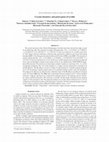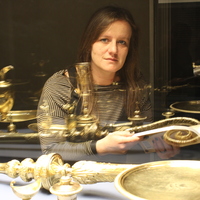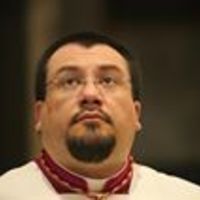Papers by Giovanni Ferraris
Bollettino Storico Vercellese , 2024
The article succinctly exposes the editorial and conference activity of the Società Storica Verce... more The article succinctly exposes the editorial and conference activity of the Società Storica Vercellese in its 52 years of existence, with particular attention to the last period in which, for four terms, I held the position of president. It is highlighted how the themes covered in the biannual Bollettino Storico Vercellese, in conferences and talks increasingly concern contemporary history, well appreciated by the majority
of the Society’s members. This appreciation also results from the fact that local media sometimes take inspiration from contemporary history essays published in the Bollettino to draw articles from them.
Bollettino Storico Vercellese, 2024
The essay publishes the profiles of the soldiers died and of the prisoners, residing in the small... more The essay publishes the profiles of the soldiers died and of the prisoners, residing in the small community of Prarolo, who fought in the Second World War. In the introductory part, the situations of the four fronts (Western Alps, Greco-Albanian, North Africa and Russia) on which the army of the Kingdom of Italy fought are briefly summarized. The small sample of fighters considered fairly represents the general
situation regarding the various fronts of the war and, even better, the multiplicity of prison camps in which Italian prisoners of war were interned in Greece, Germany, France, North Africa and United States. The essay is accompanied by rare documents taken from the personal files of the soldiers preserved in the State Archives of Vercelli.
Chemischer Informationsdienst, Jul 25, 1972
Chemischer Informationsdienst, Jun 12, 1973
Acta Crystallographica Section A, Aug 21, 1993

Le relazioni tra Arcangelo Scacchi e Quintino Sella attraverso il loro scambio Epistolare, Accdemia Pugliese delle Scienze, Atti e Relazioni, LIX (1), 195-210., 2024
THE RELATIONSHIP BETWEEN ARCANGELO SCACCHI AND QUINTINO SELLA THROUGH THEIR CORRESPONDENCE
Th... more THE RELATIONSHIP BETWEEN ARCANGELO SCACCHI AND QUINTINO SELLA THROUGH THEIR CORRESPONDENCE
The article analyzes the relationship between Scacchi and Sella recorded in their unpublished correspondence which is kept at the non-profit Sella Foundation in Biella. The correspondence covers the period 1842-1884 and the last part is of particular interest for the history of nascent national scientific institutions in the unified Italy. In fact, various letters testify to the contrast between the two personalities over the project, supported
by Sella, of merging the Accademia dei Lincei, which he remodeled to make it a national academy, and the Società dei XL which was chaired by Scacchi, eager to maintain the national representativeness it enjoyed in pre-unification Italy. The contrast did not touch personal relationships and some Sella’s letters document how he always esteemed Scacchi
and, if necessary, defended his moral integrity. Scacchi's scientific research covered in the correspondence concerns articles dedicated to aspects of crystallographic morphology, which he called polyhedry and polysymmetry, and the alleged discovery of a new chemical element
called vesbium, as well as his attempt to approach crystallographic optics. These were difficult subjects for the self-taught Scacchi, who seeks advice and approval from Sella, full involved in politics and uncertain about the validity of the results submitted to him by Scacchi.
Bollettino Storico Vercellese, 2024
The article illustrates the work of the Salesian Secondo Rastello (Prarolo 1881-Chiari 1845), aut... more The article illustrates the work of the Salesian Secondo Rastello (Prarolo 1881-Chiari 1845), author of two hymns dedicated to Saint John Bosco
De Gruyter eBooks, Dec 31, 2005

Bulletin de Minéralogie, 1982
Phaunouxite is triclinic P[-1] with a = 12.563(7), b = 12.181(6), c = 6.205(4) Å, α = 88.94(3), ß... more Phaunouxite is triclinic P[-1] with a = 12.563(7), b = 12.181(6), c = 6.205(4) Å, α = 88.94(3), ß = 91.67(3), γ = 113.44(4)°, Z = 2. The strongest lines in the X-ray powder pattern are : 11.5(10) (100), 6.23(9) ([-2]10), 5.42(8) (011, 101, 0[-1]1), 3.276(9) (2[-3]1, 310), 2.963(6) (221), 2.810(6) (112, [-2]12), 2.443(7) (1[-3]2, [-5]30, [-3]02), 2.026(6) (0[-1]3, 103). The [001] needle crystals are colourless, vitreous, and with {100} dominant ; they occur in fan-shaped clusters at Gabe-Gottes vein in Sainte-Marie-aux-Mines (Vosges) with picropharmacolite, ferrarisite and aragonite. Cleavage {100} perfect ; Dmeas = 2.28(2) g.cm⁻³, Dcalc = 2.275 g. cm⁻³. Refractive indices are : nγ = 1.556(2), nß = 1.542(2), nα = 1.532(2). 2V ≃ 80°. Only Ca, As, O and H are among the chemical constituents ; wet chemical analysis gave CaO 28.2, As₂O₅ 39,0. H₂O 31,5 %. The ideal chemical formula, Ca₃(AsO₄)₂ • 11 H₂O, was also established through crystal structure determination and the identification o...
European Journal of Mineralogy, 1997
... diffraction study ALESSANDRO PAVESE*, GIOVANNI FERRARIS**, MAURO PRENCIPE**, and RICHARD IBBE... more ... diffraction study ALESSANDRO PAVESE*, GIOVANNI FERRARIS**, MAURO PRENCIPE**, and RICHARD IBBERSON*** * Dipartimento di Science della Terra, Università di Milano, Via Botticelli 23, 1-20133 Milano, Italy. - e ...
Acta Crystallographica Section A Foundations of Crystallography, 1984
European Journal of Mineralogy, 1995

American Mineralogist, 2006
The crystal structures of the 1M and 2M polytypes of tyrolite have been solved from single-crysta... more The crystal structures of the 1M and 2M polytypes of tyrolite have been solved from single-crystal X-ray diffraction data. The structure of tyrolite-1M [monoclinic, P2/c, a = 27.562(3), b = 5.5682(7), c = 10.4662(15) Å, β = 98.074(11)°, V = 1590.3(3) Å3] has been refined to R1 = 0.086 on the basis of 2522 unique observed reflections collected using synchrotron radiation at the Swiss-Norwegian beamline BM01 of the European Synchrotron Research Facility (SNBL at the ESRF). The structure of tyrolite-2M [monoclinic, C2/c, a = 54.520(6), b = 5.5638(6), c = 10.4647(10) Å, β = 96.432(9)°, V =
3154.4(6) Å3] has been refined to R1 = 0.144 on the basis of 2666 unique observed reflections obtained from a non-merohedrally twinned crystal using in-house X-ray radiation and a STOE IPDS II image plate diffractometer. The structures are based upon complex nanolayers consisting of Cu, As, and Ca coordination polyhedra. The core of the nanolayer is a copper arsenate substructure consisting of A and B sublayers. The B sublayer consists of chains of edge-sharing Cu octahedra running along the b axis. The A sublayer contains trimeric units of Cu octahedra sharing corners with AsO4 tetrahedra. Two adjacent A sublayers are linked by the octahedral chains of the B sublayer resulting in formation of the 18 Å thick ABA slab. The ABA slab is sandwiched between sublayers of Ca2+ cations and H2O molecules. Adjacent nanolayers are connected by hydrogen bonds to the interlayer species (carbonate
anions and H2O molecules). The structures of tyrolite-1M and tyrolite-2M differ by the stacking sequence of the nanolayers only. The adjacent nanolayers in tyrolite-2M are shifted by b/2 = 2.8 Å in comparison to the relative position of the nanolayers in tyrolite-1M. The structural formula of tyrolite can be written as [Ca2Cu9(AsO4)4(OH)8(CO3)(H2O)11](H2O)x where x = 0-1.










Uploads
Papers by Giovanni Ferraris
of the Society’s members. This appreciation also results from the fact that local media sometimes take inspiration from contemporary history essays published in the Bollettino to draw articles from them.
situation regarding the various fronts of the war and, even better, the multiplicity of prison camps in which Italian prisoners of war were interned in Greece, Germany, France, North Africa and United States. The essay is accompanied by rare documents taken from the personal files of the soldiers preserved in the State Archives of Vercelli.
The article analyzes the relationship between Scacchi and Sella recorded in their unpublished correspondence which is kept at the non-profit Sella Foundation in Biella. The correspondence covers the period 1842-1884 and the last part is of particular interest for the history of nascent national scientific institutions in the unified Italy. In fact, various letters testify to the contrast between the two personalities over the project, supported
by Sella, of merging the Accademia dei Lincei, which he remodeled to make it a national academy, and the Società dei XL which was chaired by Scacchi, eager to maintain the national representativeness it enjoyed in pre-unification Italy. The contrast did not touch personal relationships and some Sella’s letters document how he always esteemed Scacchi
and, if necessary, defended his moral integrity. Scacchi's scientific research covered in the correspondence concerns articles dedicated to aspects of crystallographic morphology, which he called polyhedry and polysymmetry, and the alleged discovery of a new chemical element
called vesbium, as well as his attempt to approach crystallographic optics. These were difficult subjects for the self-taught Scacchi, who seeks advice and approval from Sella, full involved in politics and uncertain about the validity of the results submitted to him by Scacchi.
3154.4(6) Å3] has been refined to R1 = 0.144 on the basis of 2666 unique observed reflections obtained from a non-merohedrally twinned crystal using in-house X-ray radiation and a STOE IPDS II image plate diffractometer. The structures are based upon complex nanolayers consisting of Cu, As, and Ca coordination polyhedra. The core of the nanolayer is a copper arsenate substructure consisting of A and B sublayers. The B sublayer consists of chains of edge-sharing Cu octahedra running along the b axis. The A sublayer contains trimeric units of Cu octahedra sharing corners with AsO4 tetrahedra. Two adjacent A sublayers are linked by the octahedral chains of the B sublayer resulting in formation of the 18 Å thick ABA slab. The ABA slab is sandwiched between sublayers of Ca2+ cations and H2O molecules. Adjacent nanolayers are connected by hydrogen bonds to the interlayer species (carbonate
anions and H2O molecules). The structures of tyrolite-1M and tyrolite-2M differ by the stacking sequence of the nanolayers only. The adjacent nanolayers in tyrolite-2M are shifted by b/2 = 2.8 Å in comparison to the relative position of the nanolayers in tyrolite-1M. The structural formula of tyrolite can be written as [Ca2Cu9(AsO4)4(OH)8(CO3)(H2O)11](H2O)x where x = 0-1.
of the Society’s members. This appreciation also results from the fact that local media sometimes take inspiration from contemporary history essays published in the Bollettino to draw articles from them.
situation regarding the various fronts of the war and, even better, the multiplicity of prison camps in which Italian prisoners of war were interned in Greece, Germany, France, North Africa and United States. The essay is accompanied by rare documents taken from the personal files of the soldiers preserved in the State Archives of Vercelli.
The article analyzes the relationship between Scacchi and Sella recorded in their unpublished correspondence which is kept at the non-profit Sella Foundation in Biella. The correspondence covers the period 1842-1884 and the last part is of particular interest for the history of nascent national scientific institutions in the unified Italy. In fact, various letters testify to the contrast between the two personalities over the project, supported
by Sella, of merging the Accademia dei Lincei, which he remodeled to make it a national academy, and the Società dei XL which was chaired by Scacchi, eager to maintain the national representativeness it enjoyed in pre-unification Italy. The contrast did not touch personal relationships and some Sella’s letters document how he always esteemed Scacchi
and, if necessary, defended his moral integrity. Scacchi's scientific research covered in the correspondence concerns articles dedicated to aspects of crystallographic morphology, which he called polyhedry and polysymmetry, and the alleged discovery of a new chemical element
called vesbium, as well as his attempt to approach crystallographic optics. These were difficult subjects for the self-taught Scacchi, who seeks advice and approval from Sella, full involved in politics and uncertain about the validity of the results submitted to him by Scacchi.
3154.4(6) Å3] has been refined to R1 = 0.144 on the basis of 2666 unique observed reflections obtained from a non-merohedrally twinned crystal using in-house X-ray radiation and a STOE IPDS II image plate diffractometer. The structures are based upon complex nanolayers consisting of Cu, As, and Ca coordination polyhedra. The core of the nanolayer is a copper arsenate substructure consisting of A and B sublayers. The B sublayer consists of chains of edge-sharing Cu octahedra running along the b axis. The A sublayer contains trimeric units of Cu octahedra sharing corners with AsO4 tetrahedra. Two adjacent A sublayers are linked by the octahedral chains of the B sublayer resulting in formation of the 18 Å thick ABA slab. The ABA slab is sandwiched between sublayers of Ca2+ cations and H2O molecules. Adjacent nanolayers are connected by hydrogen bonds to the interlayer species (carbonate
anions and H2O molecules). The structures of tyrolite-1M and tyrolite-2M differ by the stacking sequence of the nanolayers only. The adjacent nanolayers in tyrolite-2M are shifted by b/2 = 2.8 Å in comparison to the relative position of the nanolayers in tyrolite-1M. The structural formula of tyrolite can be written as [Ca2Cu9(AsO4)4(OH)8(CO3)(H2O)11](H2O)x where x = 0-1.
Berlin, D, De Gruyter, 2015, XII + 201 pp., e99.95 (hardback), ISBN 978-3-11-041704-3
Alla vigilia della battaglia di Palestro (30-31 maggio 1859), a Prarolo, posto in sponda destra della Sesia di fronte a Palestro, si accamparono prima truppe della Terza Divisione piemontese, al comando del generale Durando, e poi la Terza armata francese al comando del generale Canrobert. Da Prarolo, i Piemontesi simularono un passaggio della Sesia il 22 maggio e i Francesi attraversarono il fiume il 31 maggio quando la battaglia di Palestro stava per concludersi. Gli eventi di Prarolo sono ricostruiti sulla base dei documenti ufficiali italiani e francesi e di numerose memorie scritte dai protagonisti. Nella prima parte del volume si dà un quadro della storia di Prarolo, località appartenuta all’Abbazia di Santo Stefano di Vercelli fino al 1801, quando il territorio fu diviso in dodici lotti acquistati da agricoltori che trasformarono completamente l’economia del paese. Sono delineate le figure di alcuni personaggi che ebbero un ruolo importante nelle vicende di Vercelli. Tra questi spicca Giuseppe Malinverni che, partendo da Prarolo dove abitava, fu a capo dei Moti del 1821 a Vercelli. Egli fu condannato a morte in contumacia e morì in esilio a Parigi nel 1856. Altro importante personaggio di Prarolo fu l’architetto Giuseppe Locarni che, tra l’altro, costruì la sinagoga di Vercelli.
Il tributo di Prarolo alla Prima Guerra Mondiale è ricostruito attraverso documenti di archivio e ricordi locali. Prarolo, una piccola comunità agricola di 1500 abitanti nei pressi di Vercelli, ebbe 350 uomini inviati al fronte; di questi, 55 morirono; 31 furono feriti (7 mutilati); 40 caddero prigionieri e 19 di loro morirono in prigionia; 4 ricevettero decorazioni al valor militare. I Caduti lasciarono 20 vedove e 27 orfani. L’economia agricola, privata della sua forza lavoro, ne uscì sconvolta. Prarolo fu tra i primi comuni a costruire un monumento ai Caduti fin dal novembre 1920, con il suo seguito di polemiche sul come valutare la perdita di tanta gioventù: gloria o inutile sacrificio? Seguì un Viale della Rimembranza nel 1924. Complessivamente, quello che successe a Prarolo può essere considerato una case story tipica di tante piccole comunità rurali pesantemente colpite dalla guerra.
Comitato Scientifico: Alessandro BARBERO, Maria Pia ALBERZONI, Giancarlo ANDENNA, Silvia FACCIN, Giovanni FERRARIS, Giorgio TIBALDESCHI